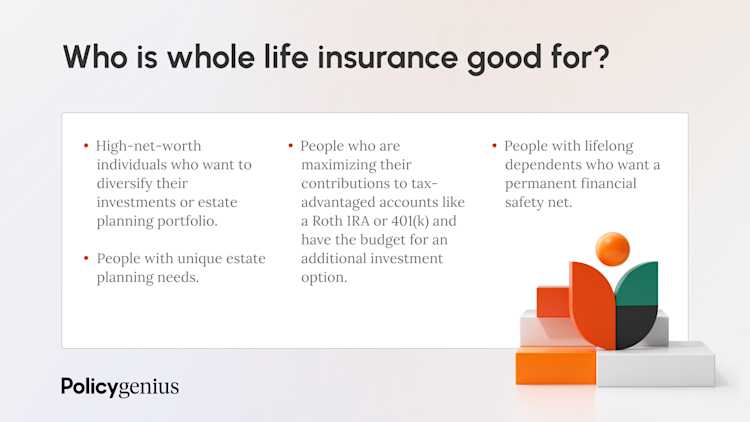How much is whole life insurance?
The average cost of whole life insurance is $440 per month. That’s the amount a 30-year-old who doesn’t smoke and is generally in good health will pay for a $500,000 whole life insurance policy.
Whole life insurance is a type of permanent life insurance that doesn’t expire. It comes with a savings feature called cash value — which you can borrow from while you’re still alive — in addition to the death benefit, which is the money your loved ones can claim when you die.
Average whole life insurance rates
Since whole life insurance doesn’t expire until your death, you’ll pay premiums for the rest of your life, or until you reach age 100. For illustration purposes, the rates below are for policies fully paid up at age 100.
Average whole life insurance rates for non-smokers by age
A 30-year-old female who doesn’t smoke and is in good health can expect to pay $408 per month for a whole life insurance policy with a $500,000 payout. A 30-year-old male with a similar profile can expect to pay $472 per month for the same coverage.
Age | Gender | $500,000 coverage amount |
|---|---|---|
20 | Female | $287 |
Male | $334 | |
30 | Female | $408 |
Male | $472 | |
40 | Female | $588 |
Male | $706 | |
50 | Female | $920 |
Male | $1,081 |
Methodology: Monthly rates are calculated for male and female non-smokers in a Preferred Plus health classification obtaining a $500,000 whole life insurance policy fully paid up at age 100 offered by Policygenius from MassMutual. Rates may vary by insurer, term, coverage amount, health class, and state. Not all policies are available in all states. Rate illustration valid as of 10/01/2024.
Average whole life insurance rates for smokers by age
A 30-year-old female smoker who’s in otherwise good health can expect to pay $505.20 per month for a whole life insurance policy with a $500,000 payout. A 30-year-old male smoker with a similar health profile can expect to pay $602.40 per month for the same coverage. People who smoke pay more for life insurance than non-smokers because the use of tobacco has known negative health effects.
Age | Gender | $500,000 coverage amount |
20 | Female | $352 |
Male | $432 | |
30 | Female | $505 |
Male | $602 | |
40 | Female | $748 |
Male | $922 | |
50 | Female | $1,193 |
Male | $1,426 |
Methodology: Approximate monthly rates are calculated for smokers in a Standard Smoker health classification based on a $500,000 whole life insurance policy fully paid up at age 100 offered by Policygenius from MassMutual. Rates may vary by insurer, term, coverage amount, health class, and state. Not all policies are available in all states. Rate illustration valid as of 10/01/2024.
Average whole life insurance rates by coverage amount
Like with other kinds of life insurance, if you purchase a higher coverage amount, you’ll pay more in premiums. Below you’ll see $1 million whole life insurance policy rates are more expensive than $500,000 whole life insurance policy rates, and so on.
Age | Gender | $250,000 coverage amount | $500,000 coverage amount | $1 million coverage amount |
|---|---|---|---|---|
20 | Female | $146 | $287 | $545 |
Male | $169 | $334 | $639 | |
30 | Female | $206 | $408 | $801 |
Male | $238 | $472 | $920 | |
40 | Female | $296 | $588 | $1,161 |
Male | $355 | $706 | $1,372 | |
50 | Female | $462 | $920 | $1,826 |
Male | $543 | $1,081 | $2,117 | |
60 | Female | $772 | $1,540 | $3,065 |
Male | $903 | $1,802 | $3,556 |
Methodology: Whole life insurance rates are calculated for male and female non-smokers in a Preferred Plus health classification obtaining a $250,000, $500,000, or $1,000,000 whole life insurance policy fully paid up at age 100 offered by Policygenius through MassMutual. Individual rates will vary as specific circumstances will affect each customer’s rate. Rate illustration valid as of 10/01/24.
Average whole life insurance rates for young adults
Age | Gender | $500,000 coverage amount, non-smoker | $500,000 coverage amount, smoker |
20 | Female | $287 | $352 |
Male | $334 | $432 | |
25 | Female | $346 | $427 |
Male | $393 | $496 | |
30 | Female | $408 | $505 |
Male | $472 | $602 | |
35 | Female | $481 | $598 |
Male | $571 | $734 |
Methodology: Rates are calculated for male and female non-smokers in a Preferred Plus health classification obtaining a $500,000 whole life insurance policy fully paid up at age 100 offered by Policygenius from MassMutual. Approximate smoker rates are calculated based on a Standard Smoker health classification for a whole life insurance policy fully paid up at age 100 from MassMutual. Rates may vary by insurer, term, coverage amount, health class, and state. Not all policies are available in all states. Rate illustration valid as of 10/01/2024.
Learn more about life insurance for young adults
Average whole life insurance rates for seniors
Seniors, including people in their 60s, 70s, and 80s with health conditions, are still eligible for whole life insurance. A licensed agent can compare options personalized for you based on your age and health — there may be some age restrictions depending on the specific type of policy you want to buy, but rest assured you’ll have coverage options.
Age | Gender | $500,000 coverage amount, non-smoker | $500,000 coverage amount, smoker |
|---|---|---|---|
60 | Female | $1,540 | $1,985 |
Male | $1,802 | $2,420 | |
65 | Female | $1,996 | $2,564 |
Male | $2,394 | $3,144 | |
70 | Female | $2,797 | $3,536 |
Male | $3,114 | $4,012 |
Methodology: Rates are calculated for male and female non-smokers in a Preferred Plus health classification obtaining a $500,000 whole life insurance policy fully paid up at age 100 offered by Policygenius from MassMutual. Approximate smoker rates are calculated based on a Standard Smoker health classification for a whole life insurance policy fully paid up at age 100 offered by Policygenius from MassMutual. Rates may vary by insurer, term, coverage amount, health class, and state. Not all policies are available in all states. Rate illustration valid as of 10/01/2024.
Read more about life insurance rates
How are whole life insurance rates determined?
The cost of whole life insurance depends on four main factors: your age, your health profile, your gender, and the type of policy you want to buy.
Age: Each year you delay buying a life insurance policy, your premiums increase between 4.5% and 9.2%.
Health: Combined with your age, your health profile has the most significant impact on your rates — in general, the younger and healthier you are, the lower the cost of your life insurance policy will be because we all become riskier to insure as we age. Certain pre-existing conditions, like heart disease, diabetes, or cancer, usually have a higher impact on your premiums. Other conditions, like asthma, sleep apnea, or high blood pressure, usually have a lower impact. Habits that affect your health, like smoking, also impact your rates, along with your family medical history
Gender: Women pay on average 24% less for life insurance than men because they have a longer life expectancy. [1]
Policy type: Permanent coverage options like whole life are significantly more expensive than term life insurance, because term life offers basic coverage in the form of a death benefit, and it expires after a set period of time — usually, between 10 and 30 years. Additionally, the type of whole life insurance you purchase will also impact the cost of your policy.
Other factors that will influence your rates — because they have the potential to increase your insurance risk — include:
Your driving record
Your lifestyle and hobbies
Your criminal history
Your credit history
Learn more about the life insurance underwriting process

Is whole life insurance more expensive than term life insurance?
Yes, whole life insurance is significantly more expensive than term life insurance. The average cost of term life insurance is just $26 per month ($312 per year) for a $500,000 20-year term life policy. Meanwhile, the average cost of whole life insurance with the same coverage amount is $451 per month ($5,412 per year).
Here are other key differences between whole life and term life.
The length of your coverage: Whole life is permanent coverage, which means it doesn’t expire. Term life lasts for a set number of years and then expires.
The cash value: Whole life has a separate cash value account, while term life does not. Term life policies don’t have a cash value — they only pay out a tax-free lump sum to the beneficiary when the policyholder dies.
Comparing whole life insurance vs. term life insurance
Features | Term life insurance | Whole life insurance |
|---|---|---|
Permanent coverage | No — maximum of 40 years | Yes |
Cost* ($500,000 coverage amount) | $26/month for a 20-year term | $451/month |
Guaranteed death benefit payout | Yes | Yes |
Guaranteed cash value | No | Yes |
Premium cost stays fixed | Yes, in most cases | Yes, in most cases |
Pays annual dividends | No | Yes, in some cases |
*Methodology: Average monthly term life insurance rate is for male and female non-smokers with a Preferred health classification obtaining a 20-year, $500,000 policy. Term life insurance averages are based on a composite of policies offered by Policygenius from Brighthouse Financial, Corebridge Financial, Foresters Financial, Legal & General America, Lincoln Financial, Mutual of Omaha, Pacific Life, Protective, Prudential, Symetra, and Transamerica, and the Policygenius Life Insurance Price Index, which uses real-time data from leading life insurance companies to determine pricing trends. Average monthly whole life insurance rate is calculated for non-smokers in a Preferred health classification, obtaining a whole life insurance policy paid up at age 100 offered by Policygenius from MassMutual. Rates may vary by insurer, term, coverage amount, health class, and state. Not all policies are available in all states. Rate illustration valid as of 10/01/2024.
Who is whole life insurance good for?
Whole life insurance can be a good fit for high-net-worth individuals who want to diversify their investments or estate planning portfolio. It can also be a good option for people who have long-term financial obligations. This includes:
People who are maximizing their contributions to tax-advantaged accounts like a Roth IRA or 401(k) and have the budget for an additional investment option
People with lifelong dependents who want a permanent financial safety net
People with unique estate planning needs
A financial planner or insurance professional can help you decide whether whole life insurance is worth it for you.
Learn more about life insurance and estate planning
How to buy whole life insurance
Buying whole life insurance is similar to buying other types of life insurance.
First, you’ll fill out an application and have a phone call with an agent.
In most cases, the next step will be to take a medical exam. This is a common part of the life insurance application process. The medical exam is similar to an annual physical, covered by the insurer, and conducted by an examiner in your home or office.
After that, the insurance company will review your application and offer you your final rate, which can take four to six weeks.
Once you sign your policy paperwork and pay your first premium, your coverage will go into effect.
An independent broker like Policygenius can help you find the best insurance policy for you and walk you through the application process. At Policygenius, our experts are licensed in all 50 states and can provide you with unbiased advice to pick the right coverage for you.
Call us at 1-800-608-2192 to connect with a Policygenius agent and get started on your application, or follow the link below.



